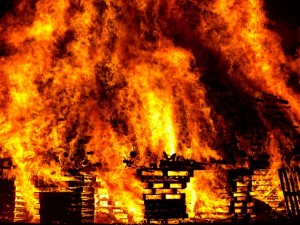Wildfire Season Starts Early Amid Drought; Costs to Top $1 Billion
 U.S. states plagued by historic drought are bracing for an early wildfire season with a cost that may rise as high as $1.8 billion, or almost $500,000 more than what’s available to control the blazes.
U.S. states plagued by historic drought are bracing for an early wildfire season with a cost that may rise as high as $1.8 billion, or almost $500,000 more than what’s available to control the blazes.
Oklahomans fought seven fires in May during what is normally the state’s quietest period. Flames scorched four times as many acres in Texas from January through May as in the same period a year earlier. California is also far ahead of its usual pace and is bracing for hundreds more containment battles throughout the most populous U.S. state.
“Drought has set the stage for a very busy and very dangerous fire season,” said Daniel Berlant, a spokesman for Cal Fire, as the Sacramento-based California Department of Forestry and Fire Protection is known. “From Jan. 1 through the end of April, we responded to 1,250 wildfires. In an average year for that same time period, we would have responded to fewer than 600.”
The 2014 season is repeating a pattern of destruction established over the past decade by a combination of high temperatures, parched vegetation and more people living in wooded areas. Fires feeding on plentiful dry grass, brush and hardwood are requiring more personnel and money to bring them under control. More than twice as many acres burned across the U.S. through May 9 this year than during the same period in 2013, according to the Boise, Idaho-based National Interagency Fire Center.
“With climate change contributing to longer and more intense wildfire seasons, the dangers and costs of fighting those fires increase substantially,” Rhea Suh, assistant secretary for policy, management and budget at the U.S. Interior Department said May 1 in a statement.
Diverting Funds
Federal officials expect to spend about $470 million more than the $1.4 billion that’s been allocated, according to a congressionally-mandated report released May 1. Increasing fire costs required the U.S. Forest Service and Interior Department to divert funds from other programs in seven of the last 12 years, the study showed. Millions of additional dollars in state and local funds are spent each year on persistent and ever- increasing blazes.
In Arizona, last year’s record-setting fire season saw 19 members of the Granite Mountain Interagency Hotshot Crew — firefighters who work behind the lines to control the spread of flames — die in the Yarnell Hill fire, the biggest loss of life from a single fire in 80 years. Colorado experienced its most destructive wildfire in history. A conflagration in Yosemite National Park that threatened San Francisco’s water supply became the largest ever in the Sierra Nevada.
Snowpack Low
With snowpack that provides water for a third of California’s farms and cities at only 18 percent of average in some places after the driest year in state history, officials expect to spend $221 million in emergency funds fighting fires by June 30, said Cal Fire’s Berlant.
In a normal year, the agency would start hiring seasonal firefighters this month. Instead, Governor Jerry Brown, a Democrat running for re-election, ordered 125 firefighters hired for the northern part of the state in January and kept seasonal crews in the south on the job longer.
Cal Fire was “never able to transition out of fire season in 2013,” according to a statement. The agency returned to peak staffing in March in San Diego, Riverside and San Bernardino counties, where equipment and facilities are staffed around the clock.
Dead brush and shrubs are drying out faster than usual in conditions more typical of mid-June than May, according to an outlook for May through August compiled by the interagency fire center.
“Fuels should remain critically dry for most of the upcoming fire season,” the report said, and be “receptive to ignition and fires that are highly resistant to control efforts.”
The risk of significant blazes will also come earlier than usual over much of the U.S. northwest, particularly in Oregon and Alaska, the outlook found. Because of substantial snowpack, the fire potential in the northern Rocky Mountains will be below normal, according to the analysis.
Colorado Governor John Hickenlooper, a Democrat running for re-election, said yesterday that several fire-prone areas saw below-average precipitation this winter including the southwest and the southeast, in the grip of an extreme drought.
‘Mitigate Danger’
“It’s up to everyone to make sure they are taking the right steps to mitigate the danger and be prepared,” Hickenlooper said in a statement. “With forecasts and planning, plus the addition of new resources related to wildfire response, we are doing what we can at the state level.”
After record-setting wildfire seasons back-to-back, Hickenlooper signed legislation setting aside almost $20 million to buy two fire-spotting planes and hire four helicopters and four large tankers for the effort.
Triple-digit temperatures that came early this year to the panhandles of Texas and Oklahoma dried grasses on what already looked like a moonscape, said Mark Svoboda, a climatologist at the National Drought Mitigation Center at the University of Nebraska-Lincoln.
Dust Bowl-like conditions in those areas and in southeastern Colorado and northern New Mexico, last seen during the 1930s, are increasing fire risk, he said.
“The droughts in California and Texas and Oklahoma are once-in-a-generation types of droughts with conditions we haven’t seen since the 1970s,” Svoboda said. “In California, the population has doubled since the 1970s, putting more structures at risk and increasing the potential loss due to fire.
Content provided by http://www.insurancejournal.com/news/national/2014/05/13/328902.htm

Comments
Not found any comments yet.